Grapevines
| Grapevines | ||||||||||||
|---|---|---|---|---|---|---|---|---|---|---|---|---|
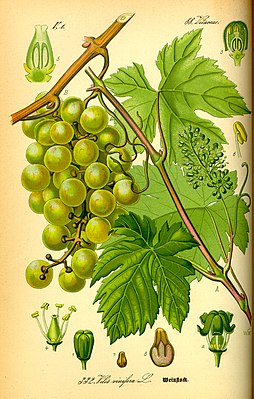
Noble grapevine ( Vitis vinifera subsp. Vinifera ), illustration |
||||||||||||
| Systematics | ||||||||||||
|
||||||||||||
| Scientific name | ||||||||||||
| Vitis | ||||||||||||
| L. |
The grapevines ( Vitis ), or vines, are a genus of plants in the grapevine family (Vitaceae). The approximately 60 species have a wide natural distribution around the world. The noble grapevine ( Vitis vinifera subsp. Vinifera ) is cultivated in many different grape varieties for wine production worldwide in suitable climatic regions ( wine-growing regions ).
description
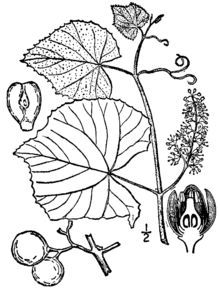
Vegetative characteristics
The grapevine species grow as evergreen or summer green, climbing shrubs or lianas . Your bark comes off in longitudinal strips. The tendril branches, which are usually two-forked, have no adhesive discs and are positioned opposite the leaves. The alternate leaves are stalked. The leaf blades are simple, lobed or sometimes hand-shaped. The stipules usually fall off early.
Generative characteristics
The grapevine species are hermaphroditic and monocial , or separate-sex-diocesan. Usually many flowers stand together in elongated, panicle or thyrsenic inflorescences , botanically incorrectly also called grapes . The flowers are radial symmetry and five-fold with a double flower envelope . The five sepals are tiny and are cup-shaped together. The five petals are fused at the top and stand out as a whole when they bloom like a cap ( kalyptra ). There is only one circle with five stamens . At the base of the ovary there is a discus that is conspicuous and five-lobed or ring-shaped. The ovary has two compartments, each with two ovules . The short, slender, conical stylus ends in a slightly extended scar .
The grapes are fleshy, spherical berries that contain two to four seeds. The hard, obovate, obovate-elliptical to pear-shaped seeds contain an M-shaped endosperm in cross-section .
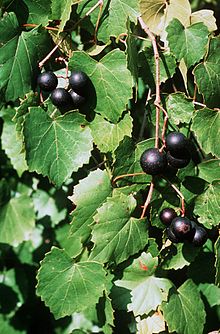


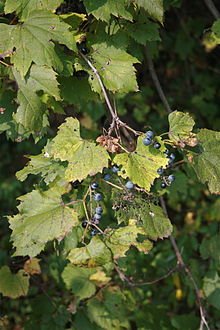
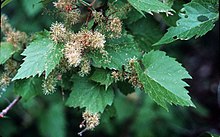

Systematics and distribution
The genus Vitis was first published in 1753 by Carl von Linné in Species Plantarum , 1, pp. 202-203. Vitis vinifera L. was used as a lectotype in 1913 by NL Britton and A. Brown in Ill. Fl. NUS , 2nd edition, 2, p. 505. Synonyms for Vitis L. are Ampelovitis Carrière , Muscadinia (Planch.) Small , Spinovitis Romanet du Caillaud and Spinovitis Carrière nom. inval.
The main focus of the natural distribution is in the temperate regions of the northern hemisphere . The genus also occurs in the tropics and subtropics of Asia, Africa and Polynesia. The centers of biodiversity are China and eastern North America. There are 37 species in China, 30 of them only there.
The genus Vitis is divided into two sub-genera with around 60 species:
- Subgenus Muscadinia Planch. : It contains two or three species that are unique to the New World:
- Vitis popenoei J.H. Fennel : It occurs in Mexico , Belize and Guatemala .
- Vitis munsoniana Simps. : It occurs in the US states of Alabama , Florida and Georgia .
- Vitis rotundifolia Michx. : It occurs in the United States. There are several varieties.
- Subgenus Vitis (Syn .: Euvitis Planch. ), See under Euvitis the further breakdown of the subgenus: It contains about 58 species:
- Vitis acerifolia Raf. (Syn .: Vitis longii W. Prince , Vitis longii var. Microsperma (Munson) LHBailey , Vitis solonis hort. Ex Planch. , Vitis solonis var. Microsperma Munson )
- Vitis adenoclada Hand.-Mazz. : It only occurs in Hunan .
-
Vitis aestivalis Michx. (Syn .: Vitis rufotomentosa Small ): It occurs in Ontario and in the United States. There are several varieties:
- Vitis aestivalis Michx. var. aestivalis (Syn .: Vitis aestivalis var. glauca (Munson) LHBailey , Vitis aestivalis var. smalliana (LHBailey) Comeaux , Vitis gigas J.H. Fennel , Vitis lincecumii var. glauca Munson , Vitis smalliana L.H.Bailey )
- Vitis aestivalis var. Bicolor Deam (Syn .: Vitis aestivalis var. Argentifolia Fernald , Vitis argentifolia Munson ex LHBailey )
- Vitis aestivalis var. Lincecumii (Buckley) Munson (Syn .: Vitis lincecumii Buckley )
-
Vitis amurensis Rupr. (Syn .: Vitis shiragae Makino ): It occurs in China, Japan, Korea and Russia. There are several varieties:
- Vitis amurensis Rupr. var. amurensis
- Vitis amurensis var. Dissecta Skvortsov
- Vitis amurensis var. Yanshanensis D.Z.Lu & HPLiang
- Vitis × andersonii Rehder (= Vitis coignetiae × Vitis riparia (as Vitis vulpina in the original description))
- Vitis arizonica Engelm. (Syn .: Vitis arizonica var. Glabra Munson ): It occurs in Mexico and in the southern United States.
-
Vitis balansana planch. : There are three varieties:
- Vitis balansana planch. var. balansana : It occurs in Vietnam and in the Chinese provinces of Guangdong , Guangxi and Hainan .
- Vitis balansana . Var ficifolioides (WTWang) CLLI (Syn .: Vitis ficifolioides W.T.Wang ): This endemic only comes in Longzhou ago in Guangxi.
- Vitis balansana var. Tomentosa C.L.Li : only occurs in Guangxi.
- Vitis barbata Wall. : It occurs in India.
- Vitis bashanica P.C. He : It only occurs in Shaanxi .
-
Vitis bellula (Rehder) WTWang : There are two varieties:
- Vitis bellula (Rehder) WTWang var. Bellula (Syn .: Vitis pentagona var. Bellula Rehder ): It thrives at altitudes of 1300 to 1600 meters in the Chinese provinces of Hubei and Sichuan .
- Vitis bellula var. Pubigera C.L.Li : It thrives at altitudes of 400 to 16,500 meters in the Chinese provinces of Guangdong, Guangxi and Hunan.
- Vitis betulifolia Diels & Gilg (Syn .: Vitis hexamera Gagnep. ): It thrives at altitudes of 600 to 3600 meters in the Chinese provinces of southeastern Gansu, Henan, Hubei, Hunan, Shaanxi , Sichuan and Yunnan .
- Vitis biformis rose : It occurs in Mexico.
- Vitis blancoi Munson : It occurs in Mexico.
- Vitis bloodworthiana Comeaux : It occurs in the Mexican states of Durango and Sinaloa .
- Vitis bourgaeana Planch. : It occurs in Mexico, Belize and Guatemala.
- Vitis × bourquiniana W.A.Taylor (= Vitis aestivalis × Vitis vinifera ?)
-
Vitis bryoniifolia Bunge : It occurs in two varieties in China:
- Vitis bryoniifolia Bunge var. Bryoniifolia (Syn .: Vitis adstricta Hance ): It occurs in the Chinese provinces of Anhui, Fujian, Guangdong, Guangxi, Hebei, Hubei, Hunan, Jiangsu, Jiangxi, Shaanxi, Shandong, Shanxi, Sichuan and Yunnan.
- Vitis bryoniifolia var. Ternata (WTWang) CLLI (Syn .: Vitis adstricta var. Ternata W.T.Wang ): it has since 2010, the rank of a kind Vitis sinoternata W.T.Wang . It only occurs in Zhejiang.
- Vitis californica Benth. : It occurs in Oregon and California.
- Vitis × champinii Planch. : It is believed to be the hybrid between Vitis mustangensis and Vitis rupestris and occurs in Texas.
- Vitis chunganensis Hu : It occurs in China.
- Vitis chungii F.P. Metcalf : It occurs in the Chinese provinces of Fujian, Guangdong, Guangxi and Jiangxi.
-
Vitis cinerea (Engelm.) Engelm. ex Millardet : It occurs in at least five varieties in North America and Mexico:
- Vitis cinerea var. Baileyana (Munson) Comeaux (subg. Vitis ) (Syn .: Vitis baileyana Munson , Vitis virginiana Munson )
- Vitis cinerea var. Cinerea ( gray cortex vine , Syn .: Vitis aestivalis var. Cinerea Engelm. )
- Vitis cinerea var. Floridana Munson (Syn .: Vitis simpsonii Munson )
- Lime vine ( Vitis berlandieri Planchon ) (Syn .: Vitis cinerea var. Helleri (LHBailey) MOMoore , Vitis cordifolia var. Helleri L.H.Bailey ): It occurs in Texas.
- Vitis coignetiae Pulliat ex Planch. (Syn .: Vitis amurensis var. Glabrescens (Nakai) Nakai , Vitis coignetiae var. Glabrescens Nakai ): It occurs in Japan, in Korea and on Sakhalin .
-
Vitis davidii (Rom. Caill.) Foëx (Syn .: Spinovitis davidii Rom. Caill. , Vitis armata Diels & Gilg ): Up to four varieties are common in China:
- Vitis davidii var. Cyanocarpa (Gagnep.) Coffin. (Syn .: Vitis armata var. Cyanocarpa Gagnep. ): It thrives at altitudes of 600 to 2300 meters in the Chinese provinces of Anhui, Hubei and Yunnan.
- Vitis davidii (Rom. Caill.) Foëx var. Davidii : It thrives at altitudes of 600 to 1800 meters in the Chinese provinces of Anhui, Chongqing , Fujian , Gansu, Guangdong, Guangxi, Guizhou, Hubei, Hunan, Jiangsu, Jiangxi, Shaanxi, Sichuan, Yunnan and Zhejiang.
- Vitis davidii var. Ferruginea Merr. & Chun : It thrives at altitudes of 500 to 1200 meters in the Chinese provinces of Fujian, Guangdong, Hubei and Jiangxi.
- Vitis davidii var. Hispida X.D.Wang & SCChen : It is said to occur in Fujian.
- Vitis × doaniana Munson ex Viala = Vitis mustangensis × Vitis acerifolia . It occurs in the United States.
- Vitis erythrophylla W.T.Wang : It occurs in Jiangxi and Zhejiang .
- Vitis fengqinensis C.L.Li : It only occurs in Yunnan .
- Vitis flexuosa Thunb. (Syn .: Vitis flexuosa var. Crassifolia Uyeki , Vitis flexuosa var. Parvifolia (Roxb.) Gagnep. , Vitis flexuosa var. Rufotomentosa Makino , Vitis flexuosa var. Tsukubana Makino , Vitis indica Thunb. , Vitis parvifolia Roxb. , Vitis wallichii DC . ): It occurs in China, India, Japan, Laos, Nepal, the Philippines, Thailand and Vietnam.
- Vitis girdiana Munson : It occurs in the US states of Arizona, Nevada, Utah, California and in Baja California ,Mexico.
- Vitis hancockii Hance : It occurs in the Chinese provinces of Anhui, Fujian, Jiangxi and Zhejiang.
-
Vitis Heyneana Roem. & Schult. (Syn .: Vitis kelungensis Momiy. , Vitis kiusiana Momiy. , Vitis lanata Roxb. , Vitis pentagona Diels & Gilg , Vitis quinquangularis Rehder ): It occurs in India, Nepal, Bhutan and China. One can distinguish between two subspecies:
- Vitis heyneana subsp. heyneana
- Vitis heyneana subsp. ficifolia (Bunge) CLLi (Syn .: Vitis ficifolia Bunge , Vitis ficifolia var. izuinsularis (Tuyama) H. Hara , Vitis ficifolia var. lobata (rule) Nakai , Vitis ficifolia var. sinuata (rule) Rehder , Vitis heyneana subsp. ficifolia (Bunge) CLLi , Vitis kaempferi K. Koch , Vitis thunbergii Siebold & Zucc. ): It occurs in China.
- Vitis hissarica Vassilcz. : It occurs in Afghanistan, Iraq and Tajikistan.
- Vitis hui W.C.Cheng : It occurs in Jiangxi and Zhejiang.
- Vitis jacquemontii R. Parker : It occurs in Pakistan, India and Nepal.
- Vitis jaegeriana Comeaux : It occurs in Mexico.
- Vitis jinggangensis W.T.Wang : It occurs in Hunan and Jiangxi.
- Vitis labrusca L. Fox vine : It is widespread in the United States.
- Vitis lanceolatifoliosa C.L.Li (Syn .: Vitis piasezkii var. Angusta W.T.Wang ): It occurs in Guangdong, Hunan and Jiangxi.
- Vitis longquanensis P.L.Chiu : It occurs in Fujian, Jiangxi and Zhejiang.
-
Vitis luochengensis W.T.Wang : It occurs in Guangdong and Guangxi. There are two varieties:
- Vitis luochengensis W.T.Wang var. Luochengensis
- Vitis luochengensis var. Tomentosonerva C.L.Li
- Vitis menghaiensis C.L.Li : It only occurs in Yunnan.
- Vitis mengziensis C.L.Li : It only occurs in Yunnan.
- Vitis monticola Buckley : It occurs in Texas.
- Vitis mustangensis Buckley (Syn .: Vitis candicans Engelm. Ex Durand ): It occurs in Alabama, Oklahoma, Louisiana and Texas.
- Vitis nesbittiana Comeaux : It occurs in the Mexican state of Veracruz.
- Vitis × novae-angliae Fernald = Vitis labrusca × Vitis riparia : It occurs in the United States.
- Vitis palmata Vahl (Syn .: Vitis rubra Michx. Ex Planch. ): It is widespread in the United States.
- Vitis pedicellata M.A. Lawson : It occurs in India and Nepal.
- Vitis peninsularis M.E. Jones : It occurs in northern Mexico.
-
Vitis piasezkii Maxim. (Syn .: Vitis baihensis P.C. He , Vitis tiubaensis L.X.Niu ): It occurs in China. There are two varieties:
- Vitis piasezkii var. Pagnuccii (Rom. Caill. Ex Planch.) Rehder (Syn .: Vitis pagnuccii Rom. Caill. Ex Planch. )
- Vitis piasezkii Maxim. var. piasezkii
- Vitis pilosonerva F.P.Metcalf : It occurs in Fujian, Guangdong and Jiangxi.
- Vitis pseudoreticulata W.T.Wang : It occurs in Korea and China.
- Vitis retordii Rome. Caill. ex planch. (Syn .: Vitis hekouensis C.L.Li ): It occurs in Laos, Vietnam and China.
- Shore Vine ( Vitis riparia Michx. ): It is widespread in Canada and the United States.
- Vitis romanetii Rome. Caill. (Syn .: Vitis romanetii var. Arachnoidea Y.L.Cao & YHHe , Vitis romanetii var. Tomentosa Y.L.Cao & YHHe ): It occurs in China and Laos.
- Vitis rupestris Scheele Sand Vine or Rock Vine : It is widespread in the central and eastern United States.
- Vitis ruyuanensis C.L.Li : It is only found in Guangdong .
- Vitis shenxiensis C.L.Li : It only occurs in Shaanxi .
- Vitis shuttleworthii House : It occurs in Florida.
- Vitis silvestrii Pamp. : It occurs in western Hubei and southern Shaanxi.
- Vitis sinocinerea W.T.Wang : It occurs in China.
- Vitis × slavinii Rehder = Vitis aestivalis × Vitis riparia : It occurs in the US state of New York.
- Vitis tiliifolia Humb. & Bonpl. ex Schult. (Syn .: Vitis caribaea DC. ): It occurs in Central America, Mexico, the Caribbean, and Colombia and Ecuador.
- Vitis treleasei Munson ex LHBailey : It is found in the southern United States.
- Vitis tsoii Merr. (Syn .: Vitis embergeri Galet ): It occurs in Fujian, Guangdong and Guangxi.
-
Vitis vinifera L .: The home is Europe, North Africa, Middle East and Central Asia. With the subspecies:
- Vitis vinifera subsp. sylvestris (CCGmel.) Hegi , Syn .: Vitis sylvestris C.C.Gmel. ( Wild grapevine )
- Vitis vinifera L. subsp. vinifera , syn .: Vitis vinifera subsp. sativa (DC.) Hegi , Edle Weinrebe Including the many grape varieties .
- Scented grapevine ( Vitis vulpina L. , Syn .: Vitis cordifolia Michx. ): It is widespread in the central and eastern United States.
- Vitis wenchouensis C.Ling ex WTWang : It only occurs in Zhejiang .
- Vitis wilsoniae H.J. Veitch : It occurs in China.
- Vitis wuhanensis C.L.Li : It occurs in China.
- Vitis xunyangensis P.C.He : It occurs in Shaanxi.
- Vitis yunnanensis C.L.Li : It only occurs in Yunnan.
- Vitis zhejiang-adstricta P.L.Chiu : It occurs in Zhejiang.
swell
- Hui Ren, Jun Wen: Vitis , p. 210 - the same text online as the printed work , In: Wu Zheng-yi, Peter H. Raven, Deyuan Hong (ed.): Flora of China , Volume 12 - Hippocastanaceae through Theaceae , Science Press and Missouri Botanical Garden Press, Beijing and St. Louis, November 19, 2007, ISBN 978-1-930723-64-1 . (Sections Description, Distribution and Systematics)
- S. Nazimuddin, M. Qaiser: Vitis in the Flora of Pakistan .
- Siegmund Seybold (Ed.): Schmeil-Fitschen interactive (CD-Rom), Quelle & Meyer, Wiebelsheim 2001/2002, ISBN 3-494-01327-6 . (for features)
- Walter Hillebrand, Heinz Lott, Franz Pfaff: Paperback of the grape varieties , 13th edition, specialist publisher Dr. Fraund GmbH, Mainz 2003, ISBN 3-921156-53-X . (for systematics)
Individual evidence
- ^ Vitis at Tropicos.org. Missouri Botanical Garden, St. Louis
- ↑ a b c d e f g h i j k l m n o p q r s t u v w x y z aa ab ac ad ae af ag ah ai aj ak al am an ao ap Vitis in the Germplasm Resources Information Network ( GRIN), USDA , ARS , National Genetic Resources Program. National Germplasm Resources Laboratory, Beltsville, Maryland.
- ↑ a b c d e f g h i j k l m n o p q r s t u v w x y z aa ab ac ad ae af ag ah ai aj ak al am an ao ap aq ar as at Hui Ren, Jun Wen: Vitis Linnaeus. , P. 210 - same text online as the printed work , In: Wu Zheng-yi, Peter H. Raven, Deyuan Hong (Ed.): Flora of China , Volume 12 - Hippocastanaceae through Theaceae , Science Press and Missouri Botanical Garden Press, Beijing and St. Louis, November 19, 2007, ISBN 978-1-930723-64-1 .